Sometimes, it's who you meet that makes writing such an interesting job. Especially if you're an artist, meeting a fellow artist – as a writer. Does that even make sense? I've noticed how great Korean design is and how quietly passionate the Japanese artists are. Here are a few that I interviewed for an exhibition hosted by K11 art mall in Tsim Sha Tsui.
25 May, 2012
24 May, 2012
Mobile M+: Yau Ma Tei (西九龍文娛藝術區)
In building interest, excitement and support of the West Kowloon Cultural District, Mobile M+: Yau Ma Tei (西九龍文娛藝術區) is the first in a series of nomadic exhibitions, curated by M+, the new museum proposed for visual culture.
The series of exhibitions include seven Hong Kong-based artists: Leung Mee-ping, Erkka Nissinen, Pak Shueng-chuen, Tsang Kin-wah, Yu Lik-wai, and collaborators Kwan Sheung-chi and Wong Wai-yin. Works can be viewed from May 15th to June 10th, 2012 and there are various artist talks throughout.
It's no surprise that the proposed district needs to build interest, excitement and support because the project has been sprinkled throughout the news for years, with various issues from proposals to planning. The first proposal in 2006 was overturned due to lack of planning and bad financing models. Luckily, it seems like art, cultural activities and visiting galleries could yet become a natural part of Hong Kong culture.
I was pleased that the venture produced an exhibition app with interactive map but it sadly appears that some issues invaded the first Mobile M+ project. And it wasn't mobile. The art was static, the viewers were mobile. So while some theme seemed to fit the displays, it's not that the pieces are moved around the city, reaching a wider audience (i.e. the more lazy or heat-fearing).
Finding addresses anywhere in Hong Kong is difficult enough, especially in areas like Mongkok and Yau Ma Tei. There's less signage on street corners, numbers don't always run in apparent succession and it's hot and crowded, which can make the most intent want to give up. Unfortunately, so will using the Mobile M+ app.
Starting in Mongkok, I couldn't find the Hong Kong Reader Book Store or 68 Sai Yeung Choi St South (site 10). I can read enough Chinese to match the book store sign in either language, but still no luck. I found No. 66 – and with seven flights to walk on a hot day, I gave up.
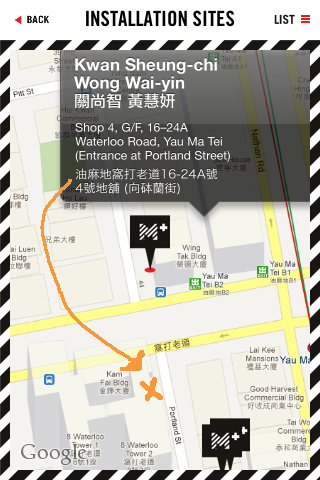
Moving on to G/F, 16–24a Waterloo Rd *enter on Portland St (site 2) to see Kwan Sheung-chi and Wong Wai-yin's collaboration, I doggedly followed the app map.
Exit B2, Yau Ma Tei. I stared at shops and numbers, I tried to spot some art, but nothing. I may have found 16 Portland St but not 16-24 Waterloo Rd. Near ready to leave, I double checked the address with my iPhone map and the site was on the other side of Waterloo Rd (X marks the spot), which you can only cross at the intersection because it's a main carriageway with cement dividers.
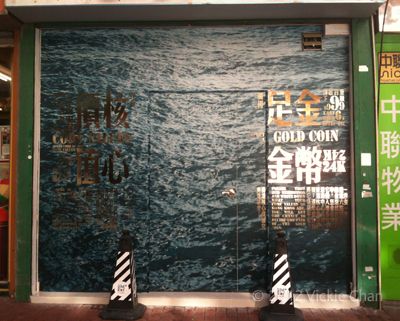
Kwan Sheung-chi and Wong Wai-yin's To Get a Gold Coin is a simple but great idea. Vote for your core values for Hong Kong and then choose whether to keep the real gold coin, or symbolically toss it into the harbour. Just the ratio of those two choices interest me, regardless of the best 'value' that's offered. It's such the Hong Kong conundrum. Preserve, love or get rich fast.
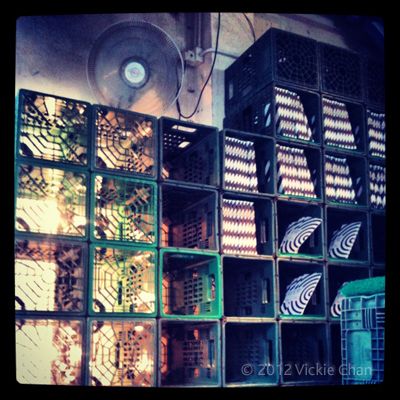
Luckily the info hub (site 1) and Yu Lik-wai's work (site 12) were opposite, in the same building as each other, on the same street.
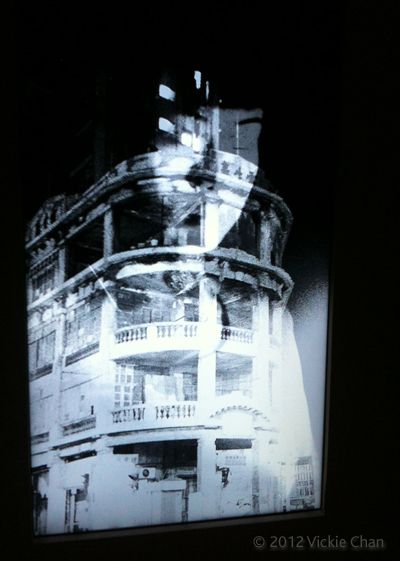
I particularly liked the use of space and Yu's dramatic use of imagery, overlapping old and new, referencing Hong Kong living spaces and people.
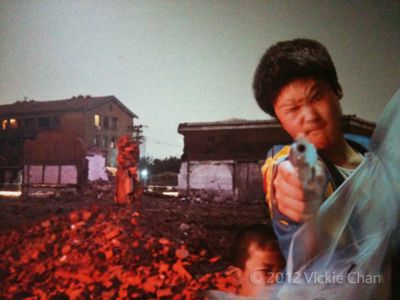
Also nearby on Portland St, sites 3 and 4 showed interesting nostalgia work by Leung Mee-ping. The recycling shop was perhaps my favourite, for so many reasons. The subtlety of the art work in situ, the explanations of those posters – it just fit seamlessly into normal Yau Ma Tei.
The thought of seeing his installation in the public sitting area lit at night was really exciting, but Mobile M+ finishes at 7pm, so I can only presume, those antiques aren't workable.
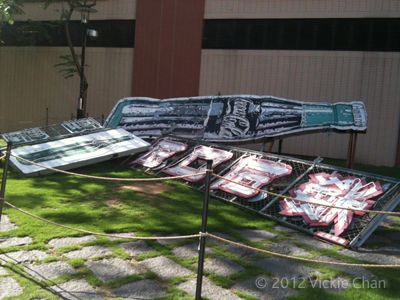
Uncle Po Bible Calligraphy (site 8) was a near miss – the TV screen was barely noticeable, perhaps because it wasn't showing Pak Sheung-chuen's work – it was blank. Wandering along to site 9 to see Pak Sheung-chuen's other work, all I could see was a white tent with fencing and chained gates, along with some Mobile M+ signage – but no art. Continuing to Kansu St to see Tsang Kin-wah's piece, I gave up. I couldn't find that one either.
While the app was frustrating to use, it's good to see digital developments and I think Mobile M+ could encourage more galleries and Hong Kong Art Fair (or Art Basel, Hong Kong) to develop apps themselves. I also wondered why the map numbered pieces all over the geographical place. Were we supposed to view them in order? Technical writers are titled as such, for a reason. Good dissemination of information.
The art that I did see from this exhibition was interesting and it's always a pleasure to see more Hong Kong artists being talked about (at #ARTHK12, I heard lots of comments about the opening night of Mobile M+). It would be nice to see a wider range of artists in the field and as time passes, hopefully we will.
For more information about the exhibition, visit the Mobile M+ site. Use maps at own risk.
18 May, 2012
The social side to social media - Meetups
Social media meetup groups are actually a great way to meet new people and it beats online dating – if you're a bit more shy than that. Plus, you can try all sorts of new things. That, and that the HK Twitter crowd are the friendliest people I've met in a while.
16 May, 2012
I Call You Nancy – Tang Kwok Hin @ Mandarin Oriental
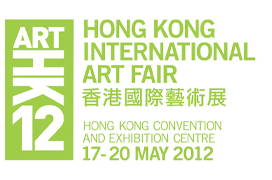
The Mandarin Oriental is the official hotel sponsor of the Hong Kong Art Fair this year. As such, not only is there a range of interesting food menus throughout the hotel, but in partnership with Contemporary by Amelia Johnson, the Clipper Lounge is also host to a specially commissioned exhibition, I Call You Nancy, by upcoming Hong Kong artist, Tang Kwok Hin.
Tang’s work is inspired by Hong Kong, creating an unmistakably nostalgic flavour, which locates the audience exactly where Tang needs them to be in order to feel what he feels. I Call You Nancy is based around Tang's made-up stories about a real sister that his mother never gave birth to, due to China's One Child Policy. While the subject matter appears to be sad, Tang masters an uplifting feeling of sensitivity, wonder and hope.
Liking the idea that by searching on Google, he could find the same images from any IP address in the world, Tang found images online to create fake memories and keepsakes about Nancy. "I liked the idea of taking public images and making a private album," he explains.
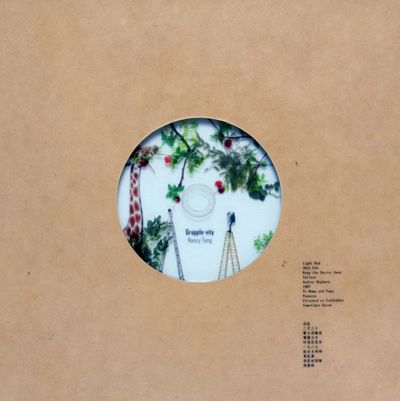
The first step in the journey is a frame full of images of 'Nancy' – but in all the images, the face is hidden or blurred. Who is Nancy? Walking through the exhibition, the audience begins to feel who she is. "I imagined she loves music, so I created these albums for her," he says. Framed in card, four sheets of glass represent a vinyl record. Images are layered in-between different layers, creating different depths and a range of blurs and illusions. Giraffes reach for the trees, leaves branch down and spacemen on ladders stretch for fruit they can't reach. The 'album' is called Grapple-vity – a combination of gravity and apple. "I wanted it to be about reaching for the sky," he explains. Which, if anything, is surely about hopeful dreaming.
Other pieces in the exhibition include a video of Tang's mother leafing through a photograph album of Nancy. He originally wanted to present the album, but the location made it impractical. In many ways, the video is more poignant, creating the real experience of Nancy. His mother cried during the filming, he says.
A stamp collection showcases images that Nancy might like, including child-like fairy tale characters like Snow White. Later, a map of the world – the one that Nancy inhabits – sandwiches unrecognisable lands between glass. Strange place names are printed on multiple levels so it's not just unclear, it's dizzying.
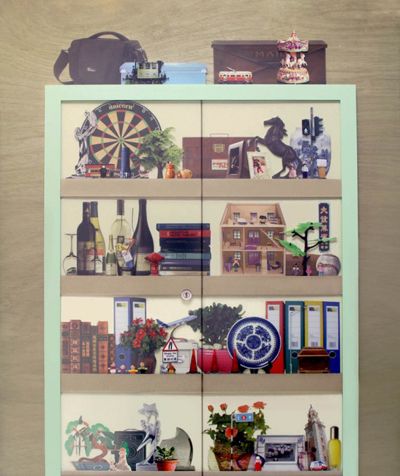
In other pieces, find different kinds of houses found around the world. Or her journeys to work and school, her different jobs. As well as being a music-lover, Tang says he imagines Nancy left to study overseas but hasn't returned, that she is a little eccentric, so he can forgive her for not contacting them. In the pieces, Nancy is always there, hidden. Another piece shows a cabinet of keepsakes and ornaments that Nancy might own – including a photo of Tang as a boy. At the end, 24 nancies collide in one piece, showing her different characteristics in one complete piece, with the backdrop of a tree and placed between wood and glass. Nature and the family tree is so strong in this piece that it's organic.
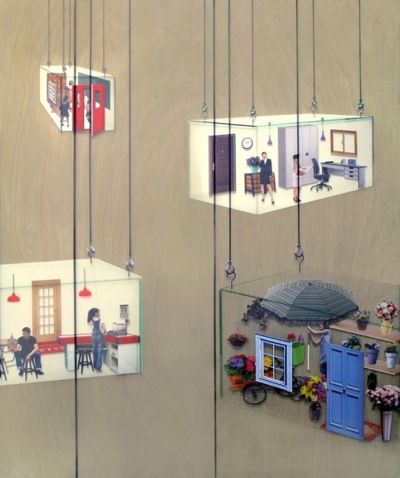
Thanks to Tang, Nancy has a life and a world all of her own. Each piece ties together different recurring elements, giving continuity in this imaginary life. "Mum tells me she would have named you Hung-jin (紅嫣). Dad still talks of the daughter he never knew. Doing this work I thought about her a lot and I feel her."
Tang was raised – and still lives – in one of Hong Kong’s last remaining walled villages, Kam Tin. Aged 28, Tang was acclaimed as Young Artist of the Year by the Hong Kong Arts Development Council in 2010 and won first prize at the Hong Kong Contemporary Art Biennale in 2009. He was also selected as a finalist for the Asian Sovereign Art Prize in both 2010 and 2011 and for the international Arte Laguna Art Prize in Venice during 2011.
After looking at Tang's work, visitors can enjoy an ART afternoon tea (3pm–6pm, Monday–Saturday; 3:30pm–6pm, Sunday – until May 26th). Michelin Star chef, Uwe Opocensky, created special cakes, inspired by Tang's collaged work (and the chocolate matchbox ganache is wonderful).

Other Hong Kong Art Fair related posts:
15 May, 2012
Hong Kong Art Fair #ARTHK 2012

In it's fifth year, the Hong Kong Art Fair is as successful as ever. During 2011, Art Basel (or, the company behind it) bought a 60% stake in the fair, which according to Fair Director, Magnus Renfrew, "secures us as an advanced art fair. It's exciting. We worked hard to make this big and Art Basel guarantees that."
Here's a list of posts about ARTHK:
Top ten tips for surviving Hong Kong Art Fair

Hong Kong Art Fair opens doors to the public this Thursday (May 17th). Each year, the fair grows in size and impact. So here are some tips on making the most of your visit to #arthk.
1. A good scout always comes prepared.
Don't go with a hangover, get a good night's sleep and be in the mood for it. To get in the mood, browse any local paper or magazine for news of the fair, or tease yourself with an imaginary shopping list to fill your house on the Peak.
2. Love your feet – be comfortable.
There are lots of elegant and stylish flats around at the moment, so don't kill your feet for art's sake. If you have an event after, take heels with you. Scheduling a foot massage afterwards is perfect – and you can chat with your friend about which pieces you liked the most.
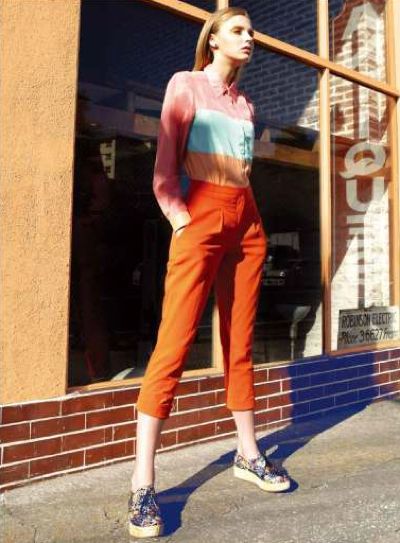
3. Timing is everything.
Try to avoid the crowds for a quieter experience and better viewing quality. Even at weekends, it's worth getting there for the midday opening as most people go after lunch. Give yourself a minimum of two hours if you want to see a handful of what's there. If you like to stop and stare, make it the bulk of your day.

If you go early, treat yourself afterwards to an ART afternoon tea at the Mandarin Oriental Clipper Lounge (3pm–6pm, Monday–Saturday; 3:30pm–6pm, Sunday). Local emerging artist Tang Kwok Hin's exhibition "I call you Nancy" is located around the room and inspired some of the delicious treats.

4. Hong Kongers drink enough bottled water a year to fill IFC. Hydrate.
A large room with UV lighting and air-con could dehydrate a camel. Take your own or buy there, but sip regularly. Typically, toilets are located and top and bottom ends of the hall. There's a map here.
5. A family af-fair
Kids are welcome at the fair so it can be a family day out. But the fair is huge. Allow toddlers to have a little run at aisle ends and take a stroller so they can fall asleep. Older kids might want to take part in activities or move on ahead/ hang back. Colour My World offer activities at the fair (details).
Have a fixed meeting point and/or in case you get separated – so everyone can enjoy the art at their own pace.
6. Wander freely... or plan ahead
Wonder freely or highlight artists and galleries you want to visit. But amazing as it is, art can satiate you, so don't force yourself to look at every piece if it will make you become blasé.
7. Come up for air
If you want to see it all, take your time and break in-between, or make two separate visits. There are various venders in the fair and other restaurants at HKCEC. Taking your own snacks would be forgiven. I vote for a brownie or cookie treat, along with good coffee. Sadly, VERO won't be returning this year – but the lounge is located close-by, at Fenwick Pier.
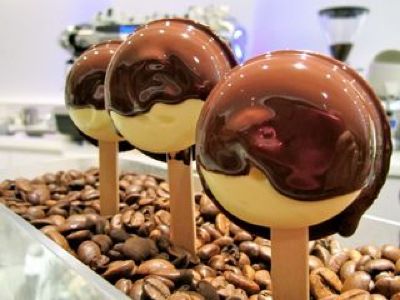
8. Shop 'til you drop.
If you're planning to buy and see something you like, don't expect to easily find the gallery space again. The fair is huge, so take a business card and note the exhibition space number as well as taking visual references. According to Fair Director, Magnus Renfrew, 40% of sales take place after the fair, so don't feel pressured to make a purchase on the spot.
9. Exit strategy.
Enough is enough and your body will tell you whether it wants to stay or not. But getting out of HKCEC can take a while if you head the wrong way (and their own floorplan isn't that helpful). Figure out if you're taking a taxi, MTR or walking and know in advance which exit you want. Expect long taxi queues at peak times, especially when the doors are closing.
10. Eat and drink 'til your heart's content.
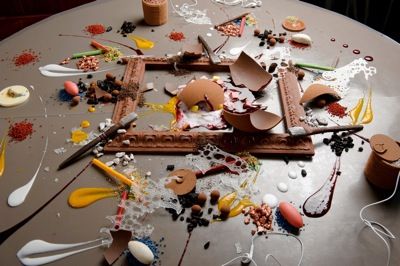
After the fair, it might well be time to eat. If it's dinner time, the Mandarin Oriental are also serving an ART menu in the Grill + Bar. Michelin-starred chef Uwe Opocensky is serving dishes like Sculpture, Graffiti, Photography, Painting and Music – so your day can end with art. In fact, the dinner includes a ticket to the fair (execpt Sunday May 20th), so you could go there the night before... but see point 1.
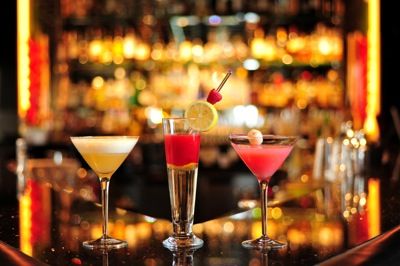
On the other hand, if you just purchased an expensive piece of art and need a stiff drink, head straight to M Bar for an ART cocktail. Future is a whiskey sour with a molecular twist, Asia One has a yuzu twist with a dash of lychee and Art is champagne with fruity end.
Other Hong Kong Art Fair related posts:
- ARTHK 12
- Tang Kwok Hin's I Call You Nancy exhibition and afternoon tea at Clipper Lounge
- Top ten tips for surviving the fair
Subscribe to:
Posts (Atom)

